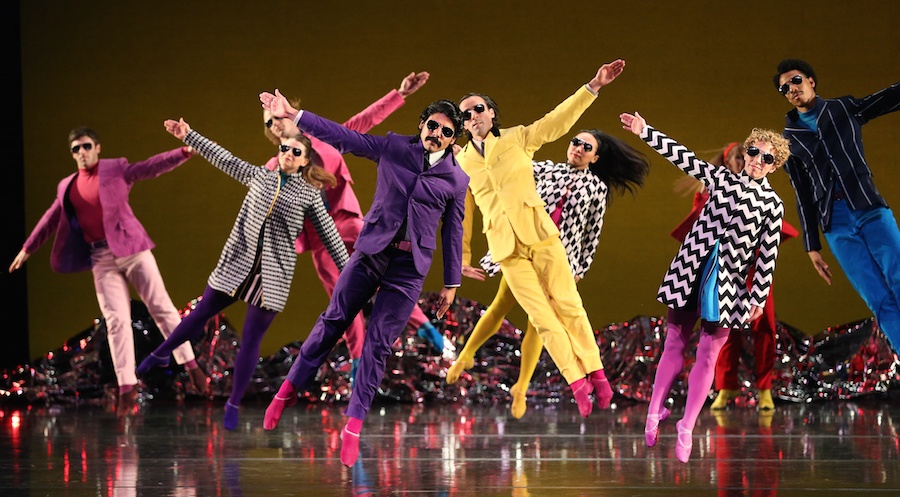
 Gareth Jones Photo.
Gareth Jones Photo.
The dancers stood in a tight circle on stage, rotating as their circle became wider to reveal the couple in the middle. All were decked out in electric blues, deep plums, and orange accents. The only trace of black showed up in a striped checkered shirt. Their faces were obscured by round sunglasses. They moved on a stage backed only by a simple set of tin foil.
These were not disco dancers, but temporary citizens of Pepperland, a multi-movement dance inspired by the Beatles album Sgt. Pepper’s Lonely Hearts Club Band, and brought into being by Mark Morris and his eponymous dance group. Thursday and Friday, the performance landed at New Haven’s Shubert Theatre as one of the final events of the International Festival of Arts & Ideas.
First conceived as a 50th anniversary tribute to Sgt. Pepper’s Lonely Hearts Club Band in Liverpool, Pepperland reimagines the Beatles’ ostensibly most famous album, staging it to a score by Mark Morris and Ethan Iverson. The two have been clear that it is an interpretation, and not direct quotation, of the music, establishing it as something that started half a century ago, but has become their own.
Sgt. Pepper was considered the first “concept album” because of its return to the opening track’s melody. The album is framed by the iconic lyrics “We hope you will enjoy the show” and “We're sorry but it's time to go.” Morris and Iverson have made good on that symmetry in Pepperland: dancers return to a circle as a central trope, looping in their movement as the album does lyrically.
The performance was set to a new composition framed by and centered on standout songs from the album, whether in sound or concept. The composition included arrangements of “Sgt. Pepper’s Lonely Hearts Club Band,” “A Little Help From My Friends,” “Within and Without You,” “Penny Lane” (not on the album but initially written for it), and “A Day in the Life.”
In the opening and closing of the show (“Sgt. Pepper’s Lonely Hearts Club Band”), they performed with a remarkable symmetry, flying through the air with one arm outstretched in perfect 90 degree angles, appearing at the top of their jumps like paper dolls hanging on a clothing line.
“With a Little Help From My Friends” was too a testament to Morris’s ability to make his dancers symmetrical artists to fluid human bodies. In the light and playful piece, Morris’s dancers performed tiny steps punctuated by sudden large jumps, hardly belabored. They were completely silent once the dancers landed, even when they threw their bodies on the floor.
However, Iverson also composed original music inspired by off-hand trombone notes he caught in the original album, the personalities on the album cover, and the concept of a “Lonely Hearts Club” in the age of Tinder.
In “When I’m Sixty Four,” the dancers formed a chorus line that followed the beats and nuances of the orchestra, whose players fell apart beat by beat. They formed a dissonant canon that the dancers followed and also fell apart with, constantly in conversation with the orchestra, rather than dancing over it.
The orchestra included only one vocalist (Clinton Curtis), with a theremin sometimes supplying another voice. The theremin sounded eerily like a replacement for a vocalist—and like the sound effects for a ghost. It was distracting at times, yet apt for dances such as “Within You Without You.”
In the piece, one dancer sat alone in the center of stage as the others danced around him, sometimes moving in unison and eventually breaking into individual movement. Influenced by George Harrison’s interest in Indian spirituality and set to the composer’s arrangement of the original record, the piece served as a fulcrum for the show that anchored it mid-performance.
Harrison’s writing, Iverson’s arrangement, Morris’s choreography and his dancers’ connection to each other cemented the song’s idea that all of man is “one.” The theremin, specifically, pulled together the orchestra and vocalists’ performance to achieve the smooth yet discordant sound of “Within You Without You.”
The dancers themselves joined the music that provided the foundation for their show, in “A Day in the Life.” Here, the choreography took on a miming aspect that seemed a strange break from the rest of the performance: “Dragged a comb across my head;” “I noticed I was late;” “had a smoke.” Yet the fusing of the dance’s voices with Curtis’s and theremin redeemed it. Before the dancers returned to their tight circle, we in the audience were able to see them finally become one with the music of Pepperland.
At the closing of the performance, a couple returned to the center of the stage and the remaining dancers took their places once more in their circle. It bookended the beginning, the beginning, as dancers of Pepperland opened themselves up to the audience. But it also reminded us that Pepperland is only a small window into the Sgt. Pepper-era.

